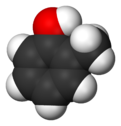- o-Cresol
-
o-Cresol 
 Systematic name2-Methylphenol[1]Other names2-Hydroxytoluene
Systematic name2-Methylphenol[1]Other names2-HydroxytolueneIdentifiers CAS number 95-48-7 
PubChem 335 UNII YW84DH5I7U 
EC number 202-423-8 UN number 2076, 3455 KEGG C01542 
MeSH 2-Cresol ChEBI CHEBI:28054 
ChEMBL CHEMBL46931 
RTECS number GO6300000 Beilstein Reference 506917 Gmelin Reference 101619 3DMet B00313 Jmol-3D images Image 1 - Cc1ccccc1O
Properties Molecular formula C7H8O Molar mass 108.14 g mol−1 Exact mass 108.057514878 g mol-1 Appearance Colorless crystals Density 1.0465 g cm-3 Melting point 31 °C, 304 K, 88 °F
Boiling point 191 °C, 464 K, 376 °F
Solubility in water 31 g dm-3 (at 40 °C) Solubility in ethanol Miscible (at 30 °C) Solubility in diethyl ether Miscible (at 30 °C) log P 1.962 Vapor pressure 40 Pa (at 20 °C) Acidity (pKa) 10.316 Basicity (pKb) 3.681 Refractive index (nD) 1.5353 Viscosity 35.06 cP (at 45 °C) Thermochemistry Std enthalpy of
formation ΔfHo298-204.3 kJ mol-1 Std enthalpy of
combustion ΔcHo298-3.6936 MJ mol-1 Standard molar
entropy So298165.44 J K-1 mol-1 Specific heat capacity, C 154.56 J K-1 mol-1 Hazards MSDS External MSDS EU Index 604-004-00-9 EU classification  T
T  C
CR-phrases R24/25, R34 S-phrases (S1/2), S36/37/39, S45 NFPA 704 Flash point 81 °C Autoignition
temperature598.9 °C Related compounds Related phenols m-cresol, p-cresol, phenol  (verify) (what is:
(verify) (what is:  /
/ ?)
?)
Except where noted otherwise, data are given for materials in their standard state (at 25 °C, 100 kPa)Infobox references ortho-Cresol, also 2-methylphenol, is a phenol, with formula (CH3)C6H4(OH).
It is an isomer of p-cresol, m-cresol and anisole
Contents
Chemistry
Cresols are organic compounds which are methylphenols. They are a widely occurring natural and manufactured group of aromatic organic compounds which are categorized as phenols (sometimes called phenolics). Depending on the temperature, cresols can be solid or liquid because they have melting points not far from room temperature. Like other types of phenols, they are slowly oxidized by long exposure to air and the impurities often give cresols a yellowish to brownish red tint. Cresols have an odor characteristic to that of other simple phenols, reminiscent to some of a "medicine" smell.
In its chemical structure, a cresol molecule has a methyl group substituted onto the benzene ring of a phenol molecule. There are three forms of cresols that are only slightly different in their chemical structure: ortho-cresol (o-cresol), meta-cresol (m-cresol), and para-cresol (p-cresol). These forms occur separately or as a mixture.
Applications
Cresols are used to dissolve other chemicals, as disinfectants and deodorizers, and to make specific chemicals that kill insect pests.
Cresol solutions are used as household cleaners and disinfectants, perhaps most famously under the trade name Lysol. In the past, cresol solutions have been used as antiseptics in surgery, but they have been largely displaced in this role by less toxic compounds. Lysol was also advertised as a disinfecting vaginal douche in mid-twentieth century America[2].
Cresols are found in many foods and in wood and tobacco smoke, crude oil, coal tar, and in brown mixtures such as creosote, cresolene and cresylic acids, which are wood preservatives. Small organisms in soil and water produce cresols when they break down materials in the environment.
Health effects
Most exposures to cresols are at very low levels that are not harmful. When cresols are breathed, ingested, or applied to the skin at very high levels, they can be very harmful. Effects observed in people include irritation and burning of skin, eyes, mouth, and throat; abdominal pain and vomiting; heart damage; anemia; liver and kidney damage; facial paralysis; coma; and death.
Breathing high levels of cresols for a short time results in irritation of the nose and throat. Aside from these effects, very little is known about the effects of breathing cresols, for example, at lower levels over longer times.
Ingesting high levels results in kidney problems, mouth and throat burns, abdominal pain, vomiting, and effects on the blood and nervous system.
Skin contact with high levels of cresols can burn the skin and damage the kidneys, liver, blood, brain, and lungs.
Short-term and long-term studies with animals have shown similar effects from exposure to cresols. No human or animal studies have shown harmful effects from cresols on the ability to have children.
It is not known what the effects are from long-term ingestion or skin contact with low levels of cresols.
External links
References
- ^ "2-Cresol - PubChem Public Chemical Database". The PubChem Project. USA: National Center for Biotechnology Information. http://pubchem.ncbi.nlm.nih.gov/summary/summary.cgi?cid=335&loc=ec_rcs.
- ^ "Lysol Douche Advertisements"
Categories:- Antiseptics
- Hazardous air pollutants
- Cresols
Wikimedia Foundation. 2010.

